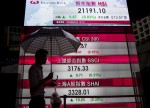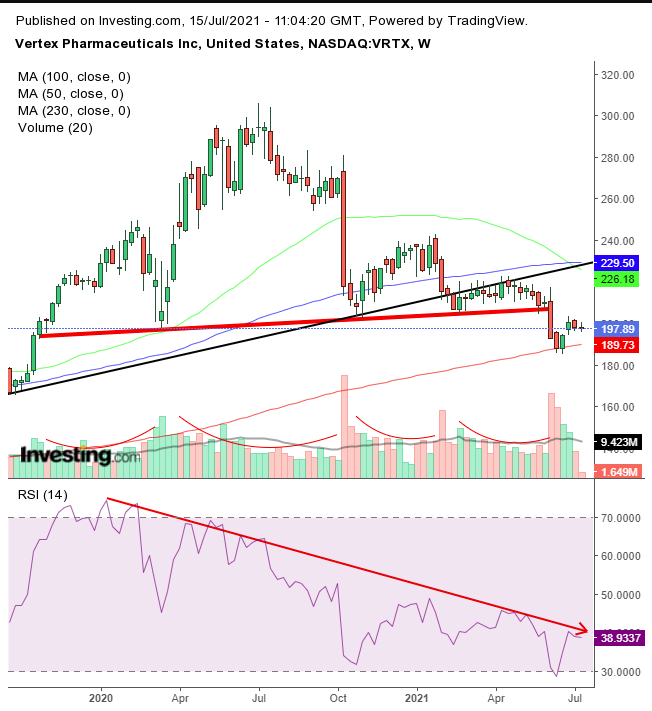
- All Instrument Types
- Indices
- Equities
- ETFs
- Funds
- Commodities
- Currencies
- Crypto
- Bonds
- Certificates
Please try another search

Chart Of The Day: Why We’re Contrarian On ESG Darling, Vertex Pharmaceuticals

Last month, Investor's Business Daily rated Vertex Pharmaceuticals (NASDAQ:VRTX) number four on its list of the best ESG stocks, awarding the company high marks for its environmental, social and governance values and practices.
The site also noted that investing in Vertex wasn't a trade-off for ethics-focused investors looking for stock strength and growth potential. The rating also reflected “broad strength in fundamental and technical areas linked to stock price performance.”
The Massachusetts-based biotech specializes in gene-editing therapies for a number of diseases including cystic fibrosis. Bank of America Managing Director Geoff Meacham concurs on the fundamentals, targeting a share price of around $275 over the next 12 months, a $75, or 28% increase from its current $198 level over the next 12 months.
The company is slated to release Q2 earnings on Thursday, July 28, after the close. It's forecast to post an EPS of $2.19 on $1.72 billion of revenue.
We're also betting on a $75 move, but in the opposite direction. Our price target points lower, to $125, for an approximate 38% decline in value. That's because, on Vertex's technical chart, the balance of supply and demand is primed for a steep decline.
During the first week of June the stock completed a massive, 19-month long H&S top, in play from November 2019 to May 2021.
The volume activity supports the reversal from buying to selling, as illustrated by the falling volume on the RSI within each rise in the price amid the H&S top, as well as the spike in volume with each drop—a sign of where the force was.
We see the same negative divergence via the falling price momentum during June and July, revealing the weakness in the pattern’s head, before forming the right shoulder and providing a downside breakout.
The price found what we expect to be its last support by the 200-week MA, while the 50-week MA already crossed below its 100-weekly counterpart, threatening a Death Cross when it will fall below the 200-week MA.
Trading Strategies
Conservative traders should wait on the possibility that the price will return all the way to the neckline and verify resistance, or close below the 200-week MA, which it will then retest from below.
Moderate traders could wait for the same trading pattern, but for a closer entry, not necessarily for further confirmation.
Aggressive traders may enter at will, provided they do so with the understanding and acceptance of the risks and according to a trading plan to which they are committed. Here’s an example:
Trade Sample
- Entry: $200
- Stop-Loss: $205
- Risk: $5
- Target: $125
- Reward: $75
- Risk:Reward Ratio: 1:15
Related Articles

The Dow Jones Industrial Average fell around 400 points on Wednesday following a hot US inflation report. However, the Dow has since recovered around 300 points to trade 0.45%...

Chili’s is back, baby: Brinker International EAT has been on a hot streak. US Foods and Shake Shack SHAK issued preliminary results last month, and both report full Q4 numbers...

Shares of tech giant Broadcom (NASDAQ:AVGO) have been a joy for investors to hold, delivering a massive 130% gain in 2024 that included an all-time high in December. It would have...
Are you sure you want to block %USER_NAME%?
By doing so, you and %USER_NAME% will not be able to see any of each other's Investing.com's posts.
%USER_NAME% was successfully added to your Block List
Since you’ve just unblocked this person, you must wait 48 hours before renewing the block.
I feel that this comment is:
Thank You!
Your report has been sent to our moderators for review






Add a Comment
We encourage you to use comments to engage with other users, share your perspective and ask questions of authors and each other. However, in order to maintain the high level of discourse we’ve all come to value and expect, please keep the following criteria in mind:
Enrich the conversation, don’t trash it.
Stay focused and on track. Only post material that’s relevant to the topic being discussed.
Be respectful. Even negative opinions can be framed positively and diplomatically. Avoid profanity, slander or personal attacks directed at an author or another user. Racism, sexism and other forms of discrimination will not be tolerated.
Perpetrators of spam or abuse will be deleted from the site and prohibited from future registration at Investing.com’s discretion.